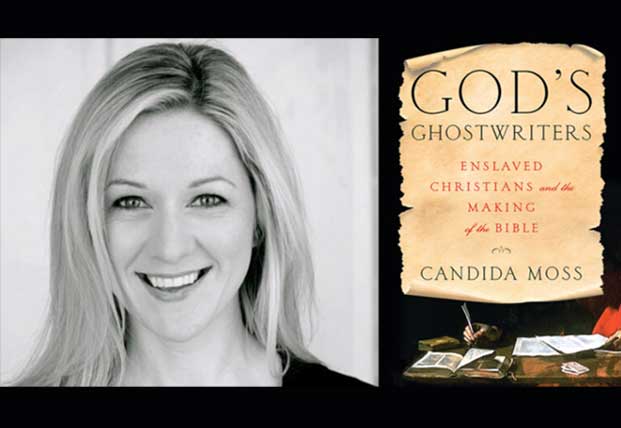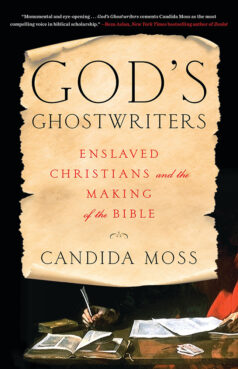Taking dictation and transcribing books — and then copying and preserving manuscripts — also requires a great deal of skill and is often overlooked. Moss said scholars tend to only think of copyists or other workers involved in preserving and passing on a text such as the New Testament when they make a mistake or introduce a change to the text.
But those same scholars fail to consider how much those copyists and other workers did right — in preserving the texts. And that erasure can create the illusion that the New Testament comes “straight from the Holy Spirit to your hand,” Moss said, downplaying the role human beings played in creating the text.
“A great scribe writes himself into nonexistence,” she said.
“God’s Ghostwriters: Enslaved Christians and the Making of the Bible” by Candida Moss. (Courtesy image)
Instead of being praised for their skill, those who preserved the text get remembered only for their mistakes.
“That negative characterization fails to represent the amount of work and craftsmanship and indeed love that went into protecting manuscripts and transmitting texts,” Moss said. “Every time someone made a change in a manuscript, they didn’t genuinely think that they were improving it. They’re not all meeting around a table to plot and strategizing about ruining ancient literature. They’re doing their very best and we only see them when they mess up.”
In writing the book, Moss drew on the techniques of scholars and historians who study the Atlantic slave trade, reconstructing the stories of enslaved people who have been erased from history. That meant looking at the roles enslaved people played in Roman society during the time the New Testament was written — and then looking for places where the stories of enslaved people may have been overlooked.
For example, Moss retells the well-known story of a paralyzed man from the Gospel of Luke. In that story, several people carry the man on a mat and lower him down through the roof of a house so Jesus can heal him. Readers of that story, said Moss, may assume the people carrying the man were friends. But the text gives few details about the people carrying the paralyzed man. And that kind of job would often have been done by slaves, she said, which would change the meaning of the story.
Recognizing the role scribes and slaves played in creating the books of the New Testament can democratize the way people read the Bible, said Moss — showing that many hands had a role to play — instead of focusing only on key religious leaders.
In the book, Moss also looks at the way early Christianity spread — from the “lectors” who would have read the text out loud in congregations to the role that word of mouth played in passing the Christian message along.
She said critics of early Christians downplayed the faith because women, slaves and other people considered to have low status were counted among the movement’s followers.
Gossip, it turns out, played a role in spreading the good news.
“When you go look at non-Christian sources, they say that Christianity spread through slaves and women and gossip,” Moss said. “That’s a whole different way of thinking about who was spreading the good news. There was this whole host of people beyond the 12 apostles and Paul who were responsible for the rise of Christianity.”
This article originally appeared here.


